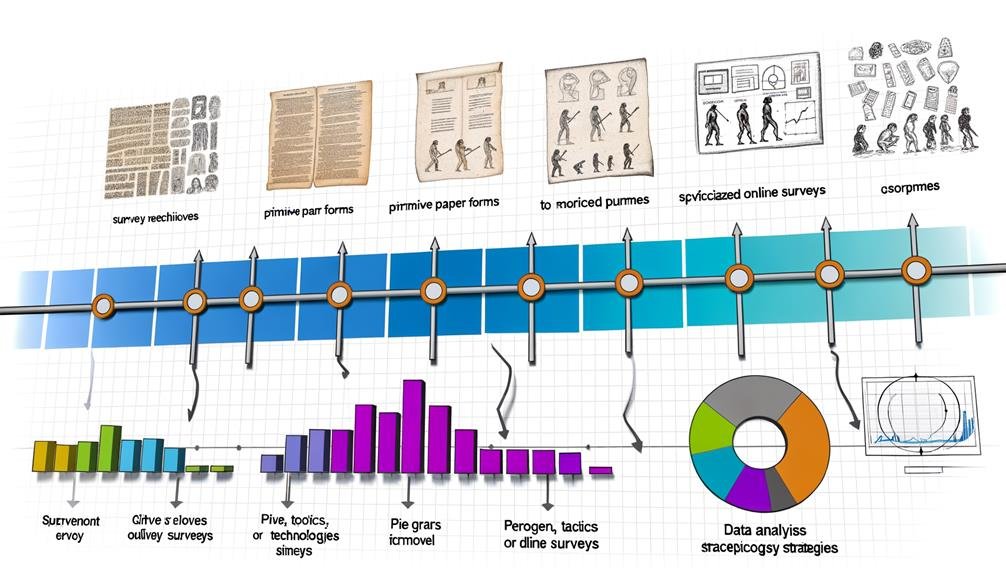Survey Design Evolution: Enhancing Data Analysis Strategies
In the realm of survey design, the evolution towards enhancing data analysis strategies has been a notable trajectory. The intricate balance between formulating clear research objectives, constructing thought-provoking questions, and employing robust data analysis methods is paramount in this progression.
However, the real intrigue lies in how these advancements are shaping the landscape of decision-making processes and the credibility of research outcomes. As we navigate through the intricacies of survey design evolution, a deeper exploration into the practical applications and implications of these strategies unveils a world where data is not just collected but truly harnessed for transformative insights.
Key Takeaways
- Enhancing Likert scales with adjectives aids in better data analysis.
- Using appropriate measurement scales improves average score calculations.
- Adding adjectives to Likert scales refines responses for nuanced interpretation.
- Evidence-based survey design leads to enhanced data analysis strategies.
Evolution of Measurement Scales
The evolution of measurement scales has been crucial in shaping the foundation of data analysis strategies by providing a structured framework for categorizing and interpreting different types of data.
Scale development and measurement techniques have played a significant role in advancing the field of data analysis. Researchers have focused on refining measurement scales to accurately capture the nuances of data, leading to improved analysis outcomes.
The development of different types of scales, such as nominal, ordinal, interval, and ratio scales, has allowed for a more precise categorization and interpretation of data. By understanding the intricacies of these measurement techniques, researchers can choose the most appropriate scale for their data collection needs, ultimately enhancing the quality and reliability of their data analysis processes.
Likert Scale Advancements
Drawing from the foundational evolution of measurement scales, advancements in Likert scale design have revolutionized data collection and analysis methodologies, leading to enhanced survey instruments and more nuanced data interpretation strategies.
Likert scale refinements have significantly contributed to improving data analysis by allowing for a more detailed understanding of respondents' attitudes and perceptions. These refinements have enabled researchers to gather more precise and insightful information, leading to more accurate data analysis improvements.
By incorporating Likert scale refinements into survey instruments, researchers can better capture the subtleties of respondents' opinions, resulting in enhanced data interpretation and more informed decision-making processes.
Adjective Integration Benefits
Advancements in Likert scale design through the integration of adjectives have significantly enhanced the granularity of data captured in survey instruments, enabling more nuanced analysis of respondents' attitudes and perceptions.
By incorporating adjectives like 'slightly' or 'strongly' into Likert scales, researchers can achieve improved response granularity, allowing for a more detailed understanding of participants' views. These adjectives introduce data interpretation nuances that go beyond simple agree/disagree options, providing a richer dataset for analysis.
The use of adjectives makes Likert scales closer to interval scales, facilitating better comparison of responses and calculation of average scores. This enhancement in Likert scale design supports more precise and insightful data interpretation in survey research.
Survey Design Applications
Integration of adjectives into Likert scales has revolutionized survey design by enabling more detailed and nuanced applications in data analysis strategies. These survey design innovations have paved the way for advanced survey methodologies and effective research strategies.
By incorporating adjectives like 'strongly agree' or 'moderately disagree' into Likert scales, researchers can gather richer data and enhance the depth of analysis. This approach allows for more precise interpretation of responses, facilitating the comparison of average scores and enabling researchers to derive more meaningful insights from the data collected.
Such enhancements in Likert scales have proven to be instrumental in improving survey design applications and optimizing data analysis techniques for more accurate and insightful research outcomes.
Evidence-Based Practices
Utilizing evidence-based practices in survey design establishes a foundation for rigorous methodology and reliable research outcomes.
- Methodology Improvement: Implementing evidence-based practices leads to continuous methodology enhancement, ensuring research integrity.
- Research Integrity: Upholding data-driven decisions based on evidence promotes survey efficacy and increases the credibility of research findings.
- Data-Driven Decisions: By prioritizing evidence-based practices, survey designers can make informed decisions that enhance survey efficacy and overall research quality.
Maximizing Data Interpretation
Maximizing data interpretation in survey design requires a meticulous analysis of measurement scales and strategic utilization of Likert scale enhancements to ensure precise and insightful research outcomes. Interpretation refinement involves understanding the nuances of different scales – nominal, ordinal, interval, and ratio – and applying suitable analysis methods for each.
Enhancing Likert scales with adjectives like 'slightly' or 'strongly' can refine responses, making them closer to interval scales and facilitating better data comparison. By considering Likert scales as interval scales, researchers can calculate average scores accurately, enabling meaningful data comparison. This approach ensures that survey data is interpreted effectively, providing valuable insights for decision-making processes based on robust data comparisons.
Enhancing Research Outcomes
To optimize the outcomes of research endeavors, meticulous attention to survey design elements and data analysis strategies is essential for ensuring the generation of meaningful and reliable insights.
When focusing on enhancing research outcomes, key considerations include:
- Implementing methodology improvements to enhance research impact.
- Incorporating advanced data analysis techniques for more robust results.
- Iteratively refining survey design to align with evolving research goals.
Conclusion
In the intricate tapestry of survey design evolution, the threads of measurement scales, Likert scale advancements, and adjective integration weave together to create a masterpiece of data analysis strategies.
By embracing evidence-based practices and maximizing data interpretation, researchers can sculpt research outcomes with precision and clarity.
Just as a skilled artisan crafts a masterpiece from raw materials, survey designers shape data into insights that illuminate the path to informed decision-making.







